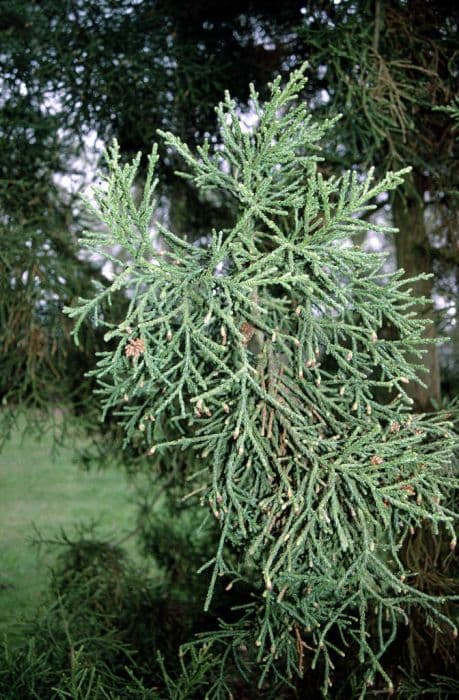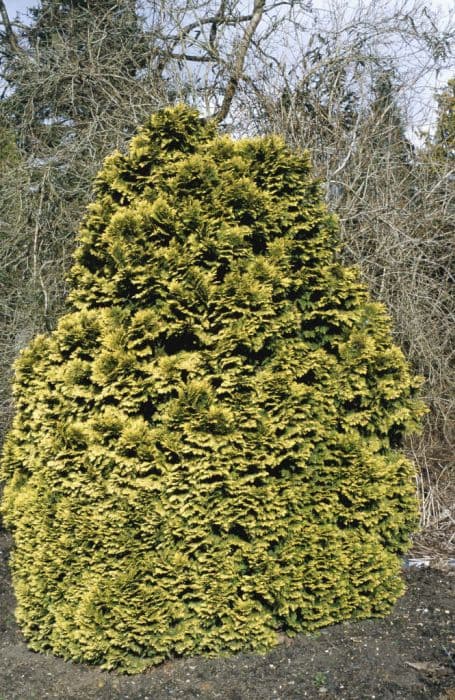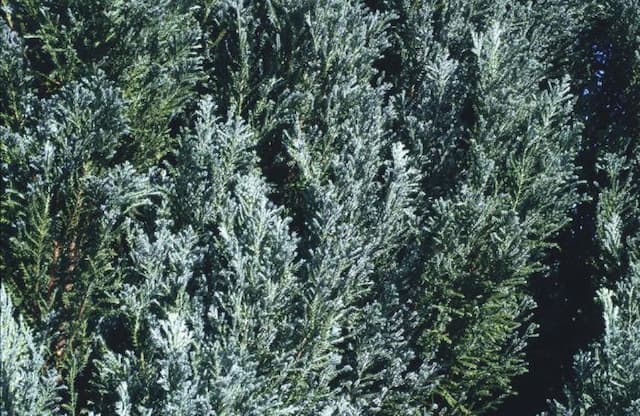Swamp cypress 'Peve Minaret' Taxodium distichum 'Pévé Minaret'











ABOUT
'Pévé Minaret' is a small, slow-growing, deciduous conifer, of columnar to pyramidal form, up to 2m tall. Soft, flat green leaves are held on ascending branchlets and turn shades of yellow and brown in the autumn
About this plant
 Names
NamesFamily
Cupressaceae
Synonyms
Dwarf Bald Cypress, Miniature Bald Cypress, Pévé Minaret Bald Cypress
Common names
Taxodium distichum 'Peve Minaret'.
 Characteristics
CharacteristicsLife cycle
Perennials
Foliage type
Deciduous
Color of leaves
Green
Height
10 feet (3 meters)
Spread
3 feet (1 meter)
Plant type
Tree
Hardiness zones
5
Native area
North America
Benefits
 General Benefits
General Benefits- Compact size: 'Pévé Minaret' is a smaller cultivar, making it suitable for smaller gardens or tight spaces.
- Ornamental value: The tree has a unique conical shape and fine, feathery foliage that provides visual interest.
- Seasonal interest: The leaves turn a coppery-bronze in fall, adding seasonal color to the landscape.
- Water tolerance: Like other bald cypresses, it can tolerate wet conditions, making it useful for planting in flood-prone areas or near water features.
- Low maintenance: It requires minimal pruning and care once established, appealing to gardeners looking for trees that don’t need a lot of attention.
- Wildlife habitat: Provides shelter and nesting sites for birds and other wildlife.
- Durable wood: While not typically harvested for lumber, bald cypress wood is known for being resistant to decay and insects.
- Longevity: It is a long-lived species, contributing to a stable and long-term landscape design.
 Medical Properties
Medical PropertiesThis plant is not used for medical purposes.
 Air-purifying Qualities
Air-purifying QualitiesThis plant is not specifically known for air purifying qualities.
 Other Uses
Other Uses- Habitat Creation: Bald cypress ‘Pévé Minaret’ can be used in landscaping to create habitats for birds, offering a safe nesting place in its dense foliage.
- Art and Sculpture: Wood from the bald cypress ‘Pévé Minaret’ can be carved and used in art projects, taking advantage of its fine grain and workability.
- Sound Barrier: The dense growth of bald cypress ‘Pévé Minaret’ can be utilized as a sound barrier to reduce noise pollution in urban gardens.
- Educational Tool: This plant variety can be used in educational settings, like schools and botanical gardens, to teach about unique cultivars and plant adaptation.
- Erosion Control: Due to its strong root system, bald cypress ‘Pévé Minaret’ can be used along waterways and in wetlands to help prevent soil erosion.
- Climbing Support: Its sturdy structure allows bald cypress ‘Pévé Minaret’ to be used as a natural support for climbing plants and vines.
- Woodworking Material: The wood of bald cypress ‘Pévé Minaret’ can be used in woodworking for creating outdoor furniture, like benches and tables, due to its resistance to water and rot.
- Model Making: The fine grain of the bald cypress wood makes it ideal for crafting detailed models and intricate woodworking projects.
- Photography Backdrop: The striking appearance and seasonal color changes of the bald cypress ‘Pévé Minaret’ make it an attractive backdrop for outdoor photography.
- Privacy Screen: When planted in rows, bald cypress ‘Pévé Minaret’ serves as a natural privacy screen, creating seclusion in garden spaces.
Interesting Facts
 Feng Shui
Feng ShuiThe Bald Cypress is not used in Feng Shui practice.
 Zodiac Sign Compitability
Zodiac Sign CompitabilityThe Bald Cypress is not used in astrology practice.
 Plant Symbolism
Plant Symbolism- Endurance: Taxodium distichum, commonly known as the Bald Cypress, is known for its ability to live for hundreds of years, representing the symbolic meaning of endurance and strength to withstand the test of time.
- Adaptability: The Bald Cypress thrives in various conditions, particularly in wet environments, symbolizing the ability to adapt and prosper in different life circumstances.
- Regeneration: This tree can regenerate from old stumps, symbolizing rebirth and the ability to recover from challenging situations.
- Resilience: Its wood is resistant to rot, and the tree can withstand hurricanes and storms, indicating resilience to life's challenges and upheavals.
 Water
WaterThe bald cypress, which is the common name for Taxodium distichum, prefers to have consistently moist soil and should be watered thoroughly once or twice a week depending on weather conditions. Newly planted trees require more frequent watering, about 15-20 gallons per week to help them establish. Once established, they are quite adaptable but still prefer moist conditions and can tolerate standing water. During dry spells or extreme heat, increase watering to prevent stress, ensuring a deep soaking that reaches the tree's root system but avoids waterlogged conditions which can be detrimental in the long run.
 Light
LightThe bald cypress thrives best in full sun conditions, meaning at least six hours of direct, unfiltered sunlight each day. It can tolerate partial shade, but its growth may be less vigorous. Ideally, the plant should be situated in a location where it receives ample morning light with some protection from harsh, afternoon sun if located in a hot climate.
 Temperature
TemperatureThe bald cypress can withstand a wide range of temperatures, but it thrives best in temperatures between 50°F and 70°F. Mature trees have been known to tolerate extreme cold down to -20°F and extreme heat up to 100°F. However, prolonged exposure outside of its ideal temperature range can stress the plant, so it should be planted in areas with moderate temperatures to ensure optimal growth.
 Pruning
PruningPruning the bald cypress should be done to shape the tree, remove any damaged or diseased branches, or control its size. The best time for pruning is late winter or early spring, before new growth starts. They don't require frequent pruning; once a year is typically sufficient, but it's important to remove dead wood and thin out dense areas to facilitate light penetration and air flow through the canopy.
 Cleaning
CleaningAs needed
 Soil
SoilThe best soil mix for the Dwarf Bald Cypress is a well-draining, consistently moist mix with good aeration. It should be slightly acidic to neutral, with an ideal pH between 5.5 and 7.0. A combination of loamy soil, peat, and sand can work well to provide the necessary conditions for healthy growth.
 Repotting
RepottingThe Dwarf Bald Cypress should be repotted only when it has outgrown its current container, which typically happens every 2 to 3 years. Being a slow grower, this plant does not need frequent repotting. When repotting, ensure the new container is only slightly larger than the previous one.
 Humidity & Misting
Humidity & MistingThe Dwarf Bald Cypress thrives in high humidity environments but is adaptable to a wide range of humidity levels. Although it naturally grows in wet conditions, the cultivated variety can tolerate average indoor humidity if kept properly watered.
 Suitable locations
Suitable locationsIndoor
Place in bright light, maintain high humidity, water regularly.
Outdoor
Full sun, moist soil, protect in harsh winters.
Hardiness zone
5-9 USDA
 Life cycle
Life cycleTaxodium distichum 'Pévé Minaret', commonly known as the Bald Cypress, begins its life as a seed, which upon finding a suitable wet and sunny environment, will germinate. After germination, the seedling will develop a taproot and begin to grow vertically, forming a small, conical shape characteristic of the 'Pévé Minaret' cultivar. As the tree matures, it will develop fine, feathery needles that are bright green in the growing season and turn a rich copper in the fall before shedding, since this is a deciduous conifer. During its growth, the tree may produce cones after a few years, which upon maturation, will disperse seeds to continue the species' life cycle. The 'Pévé Minaret' specifically is a dwarf cultivar and will reach a mature height much smaller than the species norm, typically maxing out at around 10-15 feet tall. Throughout its lifetime, which can span several centuries in ideal conditions, the Bald Cypress will continue to grow slowly in its distinctive narrow, upright form, adding to the landscape’s beauty and biodiversity.
 Propogation
PropogationPropogation time
Early Spring
Taxodium distichum 'Pévé Minaret', commonly known as the Dwarf Bald Cypress, is typically propagated by seed or vegetative methods such as cuttings. Among the propagation methods, cuttings are a popular choice due to the reliability and uniformity of the resulting plants. To propagate by cuttings, semi-hardwood cuttings are taken during the summer months when the plant is actively growing. Cuttings should be about 6 to 8 inches long (15 to 20 centimeters) and include several leaf nodes. The bottom cut should be made just below a node, and the leaves on the lower portion should be removed. The cuttings are then treated with a rooting hormone to encourage root development and are placed in a well-draining growing medium, keeping the humidity high and the temperature around 75 to 80 degrees Fahrenheit (24 to 27 degrees Celsius). With proper care, roots generally develop within a few weeks to a couple of months, after which the rooted cuttings can be transferred to pots or directly into the landscape.









